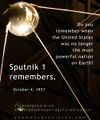File:Sputnik 1.jpg: Difference between revisions
Jump to navigation
Jump to search
No edit summary |
No edit summary |
||
| (3 intermediate revisions by the same user not shown) | |||
| Line 1: | Line 1: | ||
Sputnik 1 ( | Nonfiction: [[Sputnik 1 (nonfiction)|Sputnik 1]] (replica). National Museum of the United States Air Force, Dayton, Ohio. | ||
Sputnik 1 | == In the News == | ||
<gallery> | |||
File:Sputnik 1 Remembers.jpg|link=Sputnik 1 Remembers|Do you remember when the United States was no longer the most powerful nation on Earth? [[Sputnik 1 Remembers|Sputnik 1 remembers]]. | |||
</gallery> | |||
== Fiction cross-reference == | |||
* [[Crimes against mathematical constants]] | |||
* [[Gnomon algorithm]] | |||
* [[Gnomon Chronicles]] | |||
* [[Sputnik 1 Remembers]] | |||
== Nonfiction cross-reference == | |||
* [[Spacecraft (nonfiction)]] | |||
== External links == | |||
* [https://en.wikipedia.org/wiki/Sputnik_1 Sputnik 1] @ Wikipedia | |||
== Attribution == | |||
* By U.S. Air Force photo - http://www.nationalmuseum.af.mil; exact source, Public Domain, https://commons.wikimedia.org/w/index.php?curid=5932035 | |||
[[Category:Nonfiction (nonfiction)]] | |||
[[Category:Machines (nonfiction)]] | |||
[[Category:Photographs (nonfiction)]] | |||
[[Category:Spacecraft (nonfiction)]] | |||
Latest revision as of 05:53, 4 October 2020
Nonfiction: Sputnik 1 (replica). National Museum of the United States Air Force, Dayton, Ohio.
In the News
Do you remember when the United States was no longer the most powerful nation on Earth? Sputnik 1 remembers.
Fiction cross-reference
Nonfiction cross-reference
External links
- Sputnik 1 @ Wikipedia
Attribution
- By U.S. Air Force photo - http://www.nationalmuseum.af.mil; exact source, Public Domain, https://commons.wikimedia.org/w/index.php?curid=5932035
File history
Click on a date/time to view the file as it appeared at that time.
| Date/Time | Thumbnail | Dimensions | User | Comment | |
|---|---|---|---|---|---|
| current | 15:16, 10 July 2017 |  | 357 × 480 (27 KB) | Admin (talk | contribs) |
You cannot overwrite this file.
File usage
The following 7 pages use this file:
